geckoman1985
Well-Known Member
just heard some on lots there pet to cane toad (Bufo marinus)and was wondering if any one else has lost pets to them and should the queensland government be held responsible for it.
being a former queenslander i know what there done to native populations of reptile a was thinking should the government do more to reslove the problem as there is very little being done about it in queensland it was a silly thing thay did years ago but there no need to let it get out of hand it would be intresting to see what research has been done on tham and the impact thay have on the envirment and i wonder if there deterents that can be used that are safe fro reptiles and frog that could be used for people in queensland with pit enclosuers sorry for the los people have had with this pest and it about time the queensland government did something about it
found this site it might be a good read Cane Toads in Oz
i found this it might be a good read Cane Toads in Oz
align="center"
|-
| [h=1]TEAM BUFO'S NEW IDEAS ON CANE TOAD CONTROL[/h]We urgently need new ideas on toad control. In other pages on this website, we've explained why toads are so difficult to control, and why previous ideas on cane toad control really haven't worked. Although some scientists hope to create genetically modified viruses to kill toads, we are skeptical about the collateral damage that would arise from that approach, even if the technical obstacles could be overcome (which seems unlikely).
When Rick began his work on toads, he doubted that we would find ways to control them; cane toads are incredibly effective invasion machines! However, our research has revealed more and more chinks in the toad's armour, to the point that we are optimistic about the possibilities for toad control (though not eradication).
Team Bufo's research hasn't been designed for this purpose - our funding from the Australian Research Council is to understand toads and their effects, not to control them - but clearly it would be a terrific spin-off if that knowledge could be used to reduce the impact of cane toads on Australian biodiversity.
So, we've put special effort into parts of the research that might help in this way. That effort has been helped by extra funding from the Australian government (Department of the Environment, Water, Heritage and the Arts) to look at pheromones and spawning-site choice in toads; from the Invasive Animals Co-Operative Research Centre to explore effects of parasites on toads in Queensland; and from the Western AUstralians Department of Environment & Conservation, to understand frog and toad parasites at the toad invasion fornt. The results from that work, in combination with our other recent results from the studies at Fogg Dam, are really encouraging.
[h=2]In terms of ways to reduce the numbers and body sizes of cane toads, we have made four exciting discoveries:[/h][h=3]Alarm chemicals (“pheromones”)[/h]First, Mattias Hagman discovered that cane toad tadpoles have a special "alarm pheromone" - a chemical substance they produce when they are frightened or injured. It travels through the water and alerts nearby tadpoles that something is wrong - most likely, a predator is attacking one of your brothers or sisters - and the toad tadpoles flee as fast as they can from the chemical. Tadpoles of Australian native frogs don't react to the toad chemical - they probably don't even detect it.
 [h=3]When we added water containing the alarm pheromone to this tank (near left corner), the toad tadpoles fled from it (so are clustered in the top right corner).[/h]
[h=3]When we added water containing the alarm pheromone to this tank (near left corner), the toad tadpoles fled from it (so are clustered in the top right corner).[/h]
What use is it to frighten toad tadpoles? Well, it stresses them. In trials in outdoor ponds, adding the alarm chemical every day for a couple of weeks killed about half the toad tadpoles in our ponds. And when the survivors turned into little toads, they were tiny - less than two-thirds the weight of their brothers and sisters from the ponds next door where we hadn't added the alarm chemical. So, adding the alarm chemical to ponds can kill many toad tadpoles without affecting frog tadpoles, and can "miniaturise" the emerging toadlets.
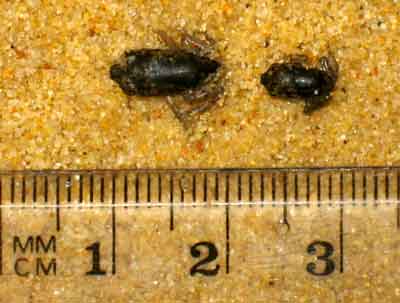 [h=3]Exposing tadpoles to the alarm pheromone makes them transform into toadlets at a much smaller size (on the right) than normal (on the left).[/h]
[h=3]Exposing tadpoles to the alarm pheromone makes them transform into toadlets at a much smaller size (on the right) than normal (on the left).[/h]
[h=3]Effects of parasites on baby toads[/h]Second, Crystal Kelehear studied a lungworm parasite that is common in Queensland cane toads, but has only recently arrived in Northern Territory cane toads (the parasites slow toads down, so have lagged behind the fast-moving toad invasion front).
Crystal infected baby toads in the laboratory, and found that the lungworm was devastating for the tiny animals - about 30% died, and the remainder grew more slowly, moved more slowly, and so on. The parasite was especially lethal to very small toads – so transforming from the tadpole stage at a small size (as happens if the tadpoles are exposed to the alarm pheromone) makes the baby toads really vulnerable to the lungworm.
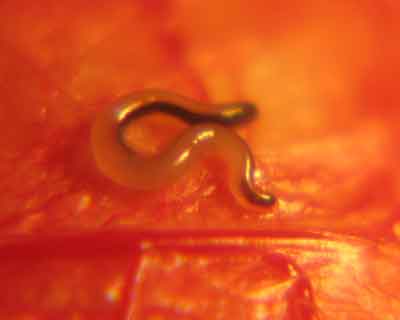 [h=3]Parasitic nematode worm in a cane toad’s lung[/h]
[h=3]Parasitic nematode worm in a cane toad’s lung[/h]
This is really encouraging - we might be able to spread the lungworm parasites around, especially to toads at the invasion front, and kill many of the baby toads as they emerge from the water. And we can increase the effect of the lungworm by spreading the alarm chemical around at the same time, to “miniaturise” the baby toads. But there's a problem - would we also kill lots of native frogs? If so, the parasite can't be used to control toads. But it turns out this isn’t likely to be a problem – read on!
[h=3]What is the parasite that lives in toad lungs?[/h]Third, Dr Sylvain Dubey has been examining just what kinds of lungworm parasites occur in toads and frogs. The parasites all look about the same, and there has always been a lot of uncertainty as to which species were which. The only reliable way to identify them is to look at their DNA sequences - a lot of work! But Sylvain has now compared DNA from lungworms found in toads (both in Australia and South America) to that from Australian frogs (mostly from Queensland, where the toads and frogs have lived side-by-side for more than 50 years).
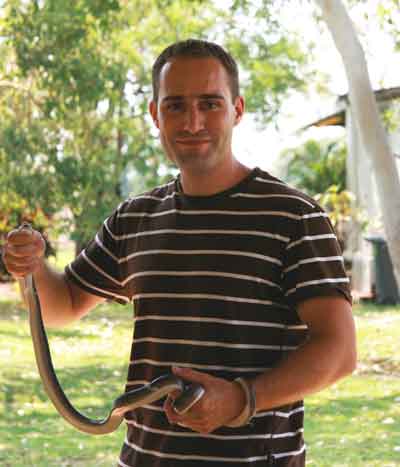 [h=3]Dr. Sylvain Dubey's skills in molecular biology gave TEAM BUFO an exciting breakthrough.[/h]
[h=3]Dr. Sylvain Dubey's skills in molecular biology gave TEAM BUFO an exciting breakthrough.[/h]
And the result amazed us. Scientists have always thought that the cane toads left their native parasites behind in the process of being moved to Australia - and so, the lungworms in Australian cane toads were believed to be a species ( Rhabdias hylae ) that is common in Australian frogs. This would make it difficult to use the lungworms to control toads - because if we made the worms more common or more infective, we'd cause problems for native frogs as well.
But Sylvain's results show that we may not have to worry about this kind of collateral damage. All of the lungworms that we have found in Australian cane toads so far are Rhabdias pseudosphaerocephala - a South American species! So the toads have brought the parasite with them, not picked it up from the Queensland locals!
And even better, all of the lungworms we have identified from the Queensland frogs are genuine Aussie species - none have been carrying the cane toad's parasite! Dr. Ligia Pizzatto has been checking this important issue by trying to infect native frogs with the toads' parasite.
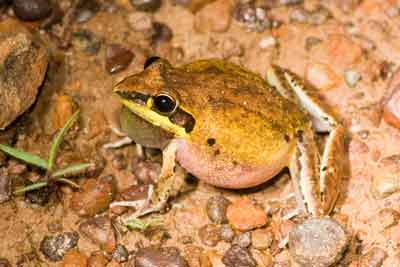
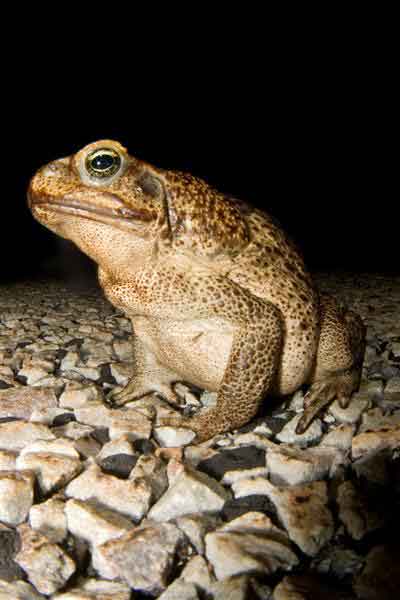
[h=3]Both frogs (above) and toads (left) have parasitic worms in their lungs, but the worms are different species.[/h]
[h=2]So, perhaps we have discovered a powerful new biological control for cane toads in Australia![/h]
[h=3]Meat ants as toad killers[/h]
Large predatory "meat ants" are common across most of Australia, and we have explored the possibility of using them to reduce cane toad numbers. Georgia Ward-Fear showed that young toads are much more vulnerable to ants than are young native frogs (toadlets are active by day in open areas and don't seem to recognise or avoid approaching ants). her field studies showed that ants kill thousands of toads, and can be encouraged to kill many more.
In summary, we have found a parasite that kills toads, but does not naturally infect Australian frogs; and an alarm chemical that kills tadpoles of toads, but not Australian frogs. And a combination of the two weapons will work even better, because the alarm chemical makes toads transform from tadpoles into toadlets at a smaller size, and so makes them even more vulnerable to the parasite. And we have a native predator that can be used to kill toads, with little or no effect on native frogs.
There's a lot more research still needed before we fully understand exactly what goes on when the parasite meets the toad. For example, how common are the parasites in areas of Queensland where the toads are common, compared to places where toads are rare - and especially, in places where the toads used to be common but have become rare? Are the parasites responsible for those variations in abundance? We still have some questions like these to answer, but we think that TEAM BUFO’s new control strategy has terrific potential, and could be implemented as soon as we have answered those questions. We are hoping to work with the Western Australian state government to start conducting exactly that research.
intresting that this reaserch has been done i would be very intrested in finding out if theres a way people on aussie pythons and help with the research but good to see that something is being done about them mby aps could sponser the research or some thing like that .
|-
being a former queenslander i know what there done to native populations of reptile a was thinking should the government do more to reslove the problem as there is very little being done about it in queensland it was a silly thing thay did years ago but there no need to let it get out of hand it would be intresting to see what research has been done on tham and the impact thay have on the envirment and i wonder if there deterents that can be used that are safe fro reptiles and frog that could be used for people in queensland with pit enclosuers sorry for the los people have had with this pest and it about time the queensland government did something about it
found this site it might be a good read Cane Toads in Oz
i found this it might be a good read Cane Toads in Oz
|-
| [h=1]TEAM BUFO'S NEW IDEAS ON CANE TOAD CONTROL[/h]We urgently need new ideas on toad control. In other pages on this website, we've explained why toads are so difficult to control, and why previous ideas on cane toad control really haven't worked. Although some scientists hope to create genetically modified viruses to kill toads, we are skeptical about the collateral damage that would arise from that approach, even if the technical obstacles could be overcome (which seems unlikely).
When Rick began his work on toads, he doubted that we would find ways to control them; cane toads are incredibly effective invasion machines! However, our research has revealed more and more chinks in the toad's armour, to the point that we are optimistic about the possibilities for toad control (though not eradication).
Team Bufo's research hasn't been designed for this purpose - our funding from the Australian Research Council is to understand toads and their effects, not to control them - but clearly it would be a terrific spin-off if that knowledge could be used to reduce the impact of cane toads on Australian biodiversity.
So, we've put special effort into parts of the research that might help in this way. That effort has been helped by extra funding from the Australian government (Department of the Environment, Water, Heritage and the Arts) to look at pheromones and spawning-site choice in toads; from the Invasive Animals Co-Operative Research Centre to explore effects of parasites on toads in Queensland; and from the Western AUstralians Department of Environment & Conservation, to understand frog and toad parasites at the toad invasion fornt. The results from that work, in combination with our other recent results from the studies at Fogg Dam, are really encouraging.
[h=2]In terms of ways to reduce the numbers and body sizes of cane toads, we have made four exciting discoveries:[/h][h=3]Alarm chemicals (“pheromones”)[/h]First, Mattias Hagman discovered that cane toad tadpoles have a special "alarm pheromone" - a chemical substance they produce when they are frightened or injured. It travels through the water and alerts nearby tadpoles that something is wrong - most likely, a predator is attacking one of your brothers or sisters - and the toad tadpoles flee as fast as they can from the chemical. Tadpoles of Australian native frogs don't react to the toad chemical - they probably don't even detect it.

What use is it to frighten toad tadpoles? Well, it stresses them. In trials in outdoor ponds, adding the alarm chemical every day for a couple of weeks killed about half the toad tadpoles in our ponds. And when the survivors turned into little toads, they were tiny - less than two-thirds the weight of their brothers and sisters from the ponds next door where we hadn't added the alarm chemical. So, adding the alarm chemical to ponds can kill many toad tadpoles without affecting frog tadpoles, and can "miniaturise" the emerging toadlets.

[h=3]Effects of parasites on baby toads[/h]Second, Crystal Kelehear studied a lungworm parasite that is common in Queensland cane toads, but has only recently arrived in Northern Territory cane toads (the parasites slow toads down, so have lagged behind the fast-moving toad invasion front).
Crystal infected baby toads in the laboratory, and found that the lungworm was devastating for the tiny animals - about 30% died, and the remainder grew more slowly, moved more slowly, and so on. The parasite was especially lethal to very small toads – so transforming from the tadpole stage at a small size (as happens if the tadpoles are exposed to the alarm pheromone) makes the baby toads really vulnerable to the lungworm.

This is really encouraging - we might be able to spread the lungworm parasites around, especially to toads at the invasion front, and kill many of the baby toads as they emerge from the water. And we can increase the effect of the lungworm by spreading the alarm chemical around at the same time, to “miniaturise” the baby toads. But there's a problem - would we also kill lots of native frogs? If so, the parasite can't be used to control toads. But it turns out this isn’t likely to be a problem – read on!
[h=3]What is the parasite that lives in toad lungs?[/h]Third, Dr Sylvain Dubey has been examining just what kinds of lungworm parasites occur in toads and frogs. The parasites all look about the same, and there has always been a lot of uncertainty as to which species were which. The only reliable way to identify them is to look at their DNA sequences - a lot of work! But Sylvain has now compared DNA from lungworms found in toads (both in Australia and South America) to that from Australian frogs (mostly from Queensland, where the toads and frogs have lived side-by-side for more than 50 years).

And the result amazed us. Scientists have always thought that the cane toads left their native parasites behind in the process of being moved to Australia - and so, the lungworms in Australian cane toads were believed to be a species ( Rhabdias hylae ) that is common in Australian frogs. This would make it difficult to use the lungworms to control toads - because if we made the worms more common or more infective, we'd cause problems for native frogs as well.
But Sylvain's results show that we may not have to worry about this kind of collateral damage. All of the lungworms that we have found in Australian cane toads so far are Rhabdias pseudosphaerocephala - a South American species! So the toads have brought the parasite with them, not picked it up from the Queensland locals!
And even better, all of the lungworms we have identified from the Queensland frogs are genuine Aussie species - none have been carrying the cane toad's parasite! Dr. Ligia Pizzatto has been checking this important issue by trying to infect native frogs with the toads' parasite.


[h=3]Both frogs (above) and toads (left) have parasitic worms in their lungs, but the worms are different species.[/h]
[h=2]So, perhaps we have discovered a powerful new biological control for cane toads in Australia![/h]
[h=3]Meat ants as toad killers[/h]
Large predatory "meat ants" are common across most of Australia, and we have explored the possibility of using them to reduce cane toad numbers. Georgia Ward-Fear showed that young toads are much more vulnerable to ants than are young native frogs (toadlets are active by day in open areas and don't seem to recognise or avoid approaching ants). her field studies showed that ants kill thousands of toads, and can be encouraged to kill many more.
In summary, we have found a parasite that kills toads, but does not naturally infect Australian frogs; and an alarm chemical that kills tadpoles of toads, but not Australian frogs. And a combination of the two weapons will work even better, because the alarm chemical makes toads transform from tadpoles into toadlets at a smaller size, and so makes them even more vulnerable to the parasite. And we have a native predator that can be used to kill toads, with little or no effect on native frogs.
There's a lot more research still needed before we fully understand exactly what goes on when the parasite meets the toad. For example, how common are the parasites in areas of Queensland where the toads are common, compared to places where toads are rare - and especially, in places where the toads used to be common but have become rare? Are the parasites responsible for those variations in abundance? We still have some questions like these to answer, but we think that TEAM BUFO’s new control strategy has terrific potential, and could be implemented as soon as we have answered those questions. We are hoping to work with the Western Australian state government to start conducting exactly that research.
intresting that this reaserch has been done i would be very intrested in finding out if theres a way people on aussie pythons and help with the research but good to see that something is being done about them mby aps could sponser the research or some thing like that .
|-
Last edited:



